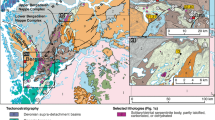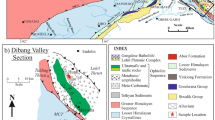Abstract
Subtropical (10°N) Ordovician carbonates are similar to modern warm-water ones and contain aChlorozoan Biota, diverse non-skeletal grains, abundant micrite, isopachous cements and early diagenetic dolomites and rare evaporites. Sr/Na ratios are around ≥ 3 as in modern warm-water carbonates. Covariance between Mn content and that of Sr and Na indicates stabilization of aragonite to calcite in a semi-closed diagenetic system. Covariance of δ18O and δ13C with Mn, Sr and Na of brachiopods and isopachous cements indicate Late Ordovician marine calcite values were around −5‰ ± 1.0 in δ18O and 1‰ ± 1.0 in δ13C. A small δ18O difference (2‰) between marine calcite and meteoric calcite indicates low latitude meteoric diagenesis. Sr/Mn ratios decrease within increasingly lighter δ13C due to dissolution of calcite in meteoric waters.
Modern and Pleistocene cool temperate (40 to 44°S) carbonates are composed mainly ofBryomol fauna with marine calcite cements and non-skeletal grains are rare. Sr, Na and Sr/Na ratios (∼1) indicate mainly calcitic mineralogy with some aragonite. Covariance between Mn content and that of Sr, Na and Sr/Na indicates marine diagenesis. The δ18O and δ13C field is characterized by heavy δ18O and moderate δ13C values and is distinctly different from the warm-water field. The δ18O and δ13C values are uniform throughout the range of Sr, Na, Mn and Sr/Mn ratios as they are unaffected by meteoric diagenesis.
Subpolar (80°S) Permian carbonates contain abundant glacial dropstones. Fauna is less diverse than in warm-water carbonates butEurydesma, brachiopods, bryozoa, pelecypods and crinoids is abundant. Marine to mixing-zone low Mg-calcite cements formed in water temperatures <3°C. Sr/Na ratios are low }1 due to calcitic mineralogy of fauna and low Mg-calcite cement. Covariance between Mn content and that of Sr and Na indicates open flow diagenesis. The δ18O and δ13C values of skeletal material are similar to those of warm Permian brachiopods and marine cements from other regions because the Tasmanian fauna either equilibrated with melt-water or melt-water diluted low salinity seawater (down to 28 ‰). The δ18O-δ13C field of whole rocks and cements falls in the mixing zone due to extensive melt-water influx. The covariance of δ18O and δ13C values with those of Sr, Na and Mn indicate a reduction of Sr and Na and an increase of Mn due to melt-water dilution. The covariance of Sr/Mn with δ13C reveals appreciable water/rock interaction with melt-waters.
Similar content being viewed by others
References
AL-AASAM, I.S., AND VEIZER, J., 1986, Diagenetic stabilization of aragonite and low Mg-calcite, I. Trace Elements in Rudists:Jour. Sed. Petrology, v. 56, p. 138–152.
ANDERSON, T.F., AND ARTHUR, M.A., 1983, Stable isotopes of oxygen and carbon and their application to sedimentologic and paleoenvironmental problems,in Stable Isotopes in Sedimentary Geology: Soc. Econ. Paleo. and Min. Short Course No. 10, p. 1-1-1-151.
BANKS, M.R. AND BAILLIE, P.W., 1989, Late Cambrian-Devonian:in Burrett, C.F., and Martin, E., eds.,Geology and Mineral Resources of Tasmania, Geol. Soc. Aust. Spec. Pub., 15, p. 182–237.
BRAKEL, A., AND TOTTERDELL, M.J., 1990, Glaciation and paleogeography of Australia at the start of Permian:Geol. Soc. Aust. Convention Abstracts, p. 63–64.
PATHURST, R.G.C., 1971,Carbonate Sediments and Their Diagenesis, Elsevier, New York, 620p.
BRAND, U., AND VEIZER, J., 1980, Chemical diagenesis of a multicomponent carbonate system. I: Trace elements:Jour. Sed. Petrology, v. 51, p. 987–997.
BROOKFIELD, M.E., 1988, A mid-Ordovician temperate carbonate shelf — the Black River and Trenton Limestone Groups of southern Ontario, Canada:in Nelson, C.S., Non-tropical Shelf Carbonates — Modern and Ancient,Sed. Geology, v. 60, p. 137–153.
BURTON, E.A., AND WALTER, L.K., 1987, Relative precipitation of aragonite and Mg-calcite from seawater: a temperature or carbonate ion control?:Geology, v. 1, p. 181–220.
COLHOUN, E.A., 1989, Quaternary:in Burrett, C.F., and Martin, E.L., eds.,Geology and Mineral Resources of Tasmania, Geol. Soc. Aust. Spec. Pub. 15, p. 410–418.
CRAIG, H, AND GORDON, L.I., 1965, Deuterium and oxygen-18 variations in the ocean and marine atmosphere,in Stable Isotopes in Oceanographic Studies and Paleotemperatures, Consiglio Nazionale delle Richerche, Laboratoria di Geologia Nucleare, Pisa, p. 1–122.
CROWELL, J.C., 1978, Gondwana glaciation, cyclothems, continental positioning, and climate change:Amer. Jour. Sci., v. 278, p. 1345–1372.
CROWELL, J.C., AND FRAKES, L.A., 1971a, Late Paleozoic glaciation of Australia:Jour. Geol. Soc. Australia, v. 17, p. 115–155.
CROWELL, J.C., AND FRAKES, L.A., 1971b, Late Paleozoic glaciation: Part IV, Australia:Geol. Soc. America Bull., v. 82, p. 2515–2540.
DANSGAARD, W., 1964, Stable isotopes in precipitation:Tellus, v. 16, p. 436–468.
DOMACK, E.W., 1988, Biogenic facies in the Antarctic glacimarine environment: Basis for a polar glacimarine summary:Paleogeo. Paleoclim. Paleoecology, v. 63, p. 357–372.
DRAPER, J.J., 1888, Permian limestone in southeastern Bowen Basin, Queensland: an example of temperate carbonate deposition:in Nelson, C.S., ed., Nontropical Shelf Carbonates — Modern and Ancient,Sed. Geology, v. 60, p. 155–162.
EMBLETON, B.J.J., 1973, The paleolatitude of Australia through Phanerozoic time:Jour. Geol. Soc. Australia, v. 19, p. 475–482.
EPSTEIN, S., AND MAYEDA, 1953, Variation of O18 content of waters from natural sources:Geochim. Cosmochim. Acta, v. 4, p. 231–244.
FOSTER, M.W., 1974, Recent Antarctic and subantarctic brachiopods:Antarctic Research Series, v. 21, 189p.
GOEDE, A., GREEN, D.C., AND HARMON, R.S., 1986, Late Pleistocene palaeotemperature record from a Tasmanian speleothem:Aust Jour. Earth Sciences, v. 33, p. 333–342.
GIVEN, R.K., AND LOHMANN, K.C., 1985, Derivation of the original isotopic composition of Permian marine cements:Jour. Sed. Petrology, v. 55, p. 430–439.
HAMBREY, M.J., AND HARLAND, W.B., 1981,Earth's Pre-Pleistocene Glacial Record: Cambridge University Press, Cambridge, 1021p.
JAMES, N.P., AND CHOQUETTE, P.W., 1983, Diagenesis 6. Limestones — The sea floor diagenetic environment:Geoscience Canada, v. 10, p. 162–179.
JAMES, N.P., AND BONE, Y., 1989, Petrogenesis of Cenozoic, temperate water calcarenites, South Australia: A model for meteoric/shallow burial diagenesis of shallow water calcite sediments:Jour. Sed. Petrology, v. 59, p. 191–203.
KEITH, M.L., 1969, Isotopic composition of carbonates from the Karroo and comparison with the Pass Dois group of Brazil,in Gondwana Stratigraphy (IUGS Symposium, Bueno Aires, 1967), UNESCO (Paris) Earth Sci. Ser., v. 2, p.775–778.
KINSMAN, D.J.J., 1969, Interpretation of Sr+2 concentrations in carbonate minerals and rocks:Jour. Sed. Petrology, v. 39, p. 486–508.
KINSMAN, D.J.J., AND HOLLAND, H.D., 1969, The co-reprecipitation of cations with CaCO3, IV. The co-reprecipitate of Sr+2 with aragonite between 16° and 96°C:Geochim. Cosmochim. Acta, v. 33, p. 1–17.
LAND, L.S., AND HOOPS, G.K., 1973, Sodium in carbonate sediments and rocks: A possible index to the salinity of diagenetic solutions:Jour. Sed. Petrology, v. 43, p. 614–617.
LECLERQ, F., 1976, Permien des Friendly Beaches, Tasmanie Orientale, Australia [unpub. PhD. thesis] Lille, France, Univ. Lille, 521p.
LEES, A., 1975, Possible influence of salinity and temperature on modern shelf carbonate sedimentation:Mar. Geology, v. 19, p. 159–198.
LOHMANN, K.C., 1988, Geochemical patterns of meteoric diagenetic systems and their application to studies of paleokarst:in James, N.P. and Choquette, P.W., eds.,Paleokarst. Springer-Verlag, New York, p.58–80.
MACKENZIE, F.T., AND PIGOTT, J.D., 1981, Tectonic controls of Phanerozoic sedimentary rock cycling:Jour. Geol. Soc. London, v. 138, p. 183–196.
MEYERS, W.J., AND LOHMANN, K.C., 1985, Isotope geochemistry of regionally extensive calcite cement zones and marine components in Mississippian limestone, New Mexico,in Schneiderman, N., and Harris, P.M., eds.,Carbonate Cements, Soc. Econ. Paleo. and Min. Spec. Pub. 36, p. 223–240.
MILLIMAN, J.D., 1974,Marine Carbonates, Recent Sedimentary Carbonates, Pt. 1, New York, Springer-Verlag, 375p.
MILLIMAN, J.D., AND MULLER, J., 1977, Characteristics and genesis of shallow-water and deep-sea limestones,in Anderson, N.R., and Malahoff, A. eds.,The Fate of Fossil Fuel CO2in the Ocean: New York, Plenum Press, p. 655–672.
MUCCI, A., 1988, Manganese uptake during calcite precipitation from seawater: conditions leading to the formation of a psedokutnahorite:Geochim. Cosmochim. Acta, v. 52, p. 1859–1866.
NELSON, C.S., 1978, Temperate shelf carbonate sediments in the Cenozoic of New Zealand:Sedimentology, v. 25, p. 737–771.
NELSON, C.S., 1988, An introductory perspective on non-tropical shelf carbonates,in Nelson, C.S., ed., Non-tropical Shelf Carbonates — Modern and Ancient,Sed. Geology, v. 60, p.3–12.
PINGITORE, N.R., 1978, The behaviour of Zn and Mn during carbonate diagenesis: theory and applications:Jour. Sed. Petrology, v. 48, p. 799–814.
PINGITORE, N.R., EASTMAN, M.P., SANDIDGE, M., ODEN, K., AND FREIHA, B., 1988, The co-precipitation of Manganese (II) with calcite: an experimental study:Marine Chemistry, v. 25, p. 107–120.
POPP, B.N., ANDERSON, T.F., AND SANDBERG, P.A., 1986, Brachiopods as indicators of original composition in some Paleozoic limestones:Geol. Soc. Amer. Bull., v. 97, p. 1262–1269.
RAO, C.P., 1981a, Cementation in cold-water bryozoan sand, Tasmania, Australia:Mar. Geology, v. 40, p. M23-M33.
RAO, C.P., 1981b, Criteria for recognition of coldwater carbonate sedimentation: Berriedale Limestone (Lower Permian), Tasmania, Australia:Jour. Sed. Petrology, v. 51, p. 491–506.
RAO, C.P., 1981c, Geochemical differences between tropical (Ordovician) and subpolar (Permian) carbonates, Tasmania, Australia:Geology, v. 9, p. 205–209.
RAO, C.P., 1983, Geochemistry of Early Permian cold-water carbonates (Tasmania, Australia):Chem. Geology, v. 38, p. 307–319.
RAO, C.P., 1986, Geochemistry of temperate-water carbonates, Tasmania, Australia:Mar. Geology, v. 71, p. 363–370.
RAO, C.P., 1988a, Paleoclimate of some Permo-Triassic carbonates of Malaysia,in Nelson, C.S., ed., Non-Tropical Shelf Carbonates — Modern and Ancient,Sed. Geology, v. 60, p. 163–171.
RAO, C.P., 1988b, Oxygen and carbon isotope composition of cold-water Berriedale Limestone (Lower Permian), Tasmania, Australia, in Nelson, C.S., ed., Non-Tropical Shelf Carbonates — Modern and Ancient,Sed. Geology, v. 60, p. 221–231.
RAO, C.P., 1989, Geochemistry of the Gordon Limestone (Ordovician), Mole Creek, Tasmania:Aust. Jour. Earth Sciences, v. 36, p. 65–71.
RAO, C.P., 1990a, Geochemical characteristics of cool-temperate carbonates, Tasmania, Australia:Carbonates and Evaporites v. 5, no. 2, p. 209–221.
RAO, C.P., 1990b, Marine to mixing zone dolomitization in peritidal carbonates: Gordon Group carbonates (Ordovician), Mole Creek, Tasmania, Australia:Carbonates and Evaporites v. 5, no. 2, p. 153–178.
RAO, C.P., 1990c, Petrography, trace elements and oxygen and carbon isotopes of Gordon Group carbonates (Ordovician), Florentine Valley, Tasmania, Australia:Sed. Geology, v. 66, p. 83–97.
RAO, C.P., AND NAQVI, I.H., 1977, Petrography, geochemistry and factor analysis of a Lower Ordovician subsurface sequence, Tasmania, Australia:Jour. Sed. Petrology, v. 47, p. 1036–1055.
RAO, C.P., AND GREEN, D.C., 1982, Oxygen and carbon isotopes of Early Permian cold-water carbonates, Tasmania, Australia:Jour. Sed. Petrology, v. 52, p. 1111–1125.
RAO, C.P., AND GREEN, D.C., 1983, Oxygen- and carbon-isotope composition of cold shallow-marine carbonates of Tasmania, Australia:Mar. Geology, v. 53, p. 117–129.
RAO, C.P., AND WANG, B., 1990, Oxygen and carbon isotope composition of Gordon Group carbonates (Ordovician), Florentine Valley, Tasmania, Australia:Aust. Jour. Earth Sci., v 37, 305–316.
REECKMAN, S.A., 1988, Diagenetic alterations in temperate shelf carbonates from southeastern Australia,in Nelson, C.S., ed., Non-Tropical Shelf Carbonates,Sed. Geology, v. 60, p. 209–219.
ROBINSON, P., 1980, Determination of calcium, magnesium, manganese, strontium, sodium and iron in carbonate fraction of limestone and dolomite:Chem. Geology, v. 28, p. 135–146.
ROSS, R.J., Jr., JAANUSSON, V., AND FRIEDMAN, I., 1975, Lithology and origin of Middle Ordovician calcareous mudmound of Meiklejohn Peak, Southern Nevada: United States Geol. Surv. Prof. Paper 871, 48p.
RUNNEGAR, B., 1979, Ecology ofEurydesma andEurydesma faunas, Permian of eastern Australia:Alcheringa, v. 3, p. 261–285.
SANDBERG, P.A., 1983, An oscillating trend in Phanerozoic non-skeletal carbonate mineralogy:Nature, v. 305, p. 19–22.
SHINN, E.A., 1983, Birdseye, fenestrae, shrinkage pores, and loferites: a re-evaluation:Jour. Sed. Petrology, v. 53, p. 619–628.
SCHMIDT, D.L., AND FRIEDMAN, I., 1974, Continental deposition of Artarctic tillite indicated by carbon and oxygen isotopes:U.S. Geol. Surv. Jour. Research v. 2, p. 711–715
VEIZER, J., 1977, Diagenesis of pre-Quaternary carbonates as indicated by tracer studies:Jour. Sed. Petrology, v. 46, p. 565–581.
VEIZER, J., 1983, Chemical diagenesis of carbonates: Theory and application of trace element technique. in Stable Isotopes in Sedimentary Geology, Soc. Econ. Paleo. and Min., Short Course No. 10, 3-1-3-100.
VEIZER, J., FRITZ, P., AND JONES, B., 1986, Geochemistry of brachiopods: oxygen and carbon isotopic records of Paleozoic oceans:Geochim. Cosmochim. Acta, v. 50, p. 1679–1696.
WILKINSON, B.H., 1982, Cyclic cratonic carbonates and Phanerozoic calcite seas:Jour. Geol. Education, v. 30, p. 189–203.
Author information
Authors and Affiliations
Rights and permissions
About this article
Cite this article
Rao, C.P. Geochemical differences between subtropical (Ordovician), cool temperate (Recent and Pleistocene) and subpolar (Permian) carbonates, tasmania, australia. Carbonates Evaporites 6, 83–106 (1991). https://doi.org/10.1007/BF03175385
Received:
Accepted:
Published:
Issue Date:
DOI: https://doi.org/10.1007/BF03175385




